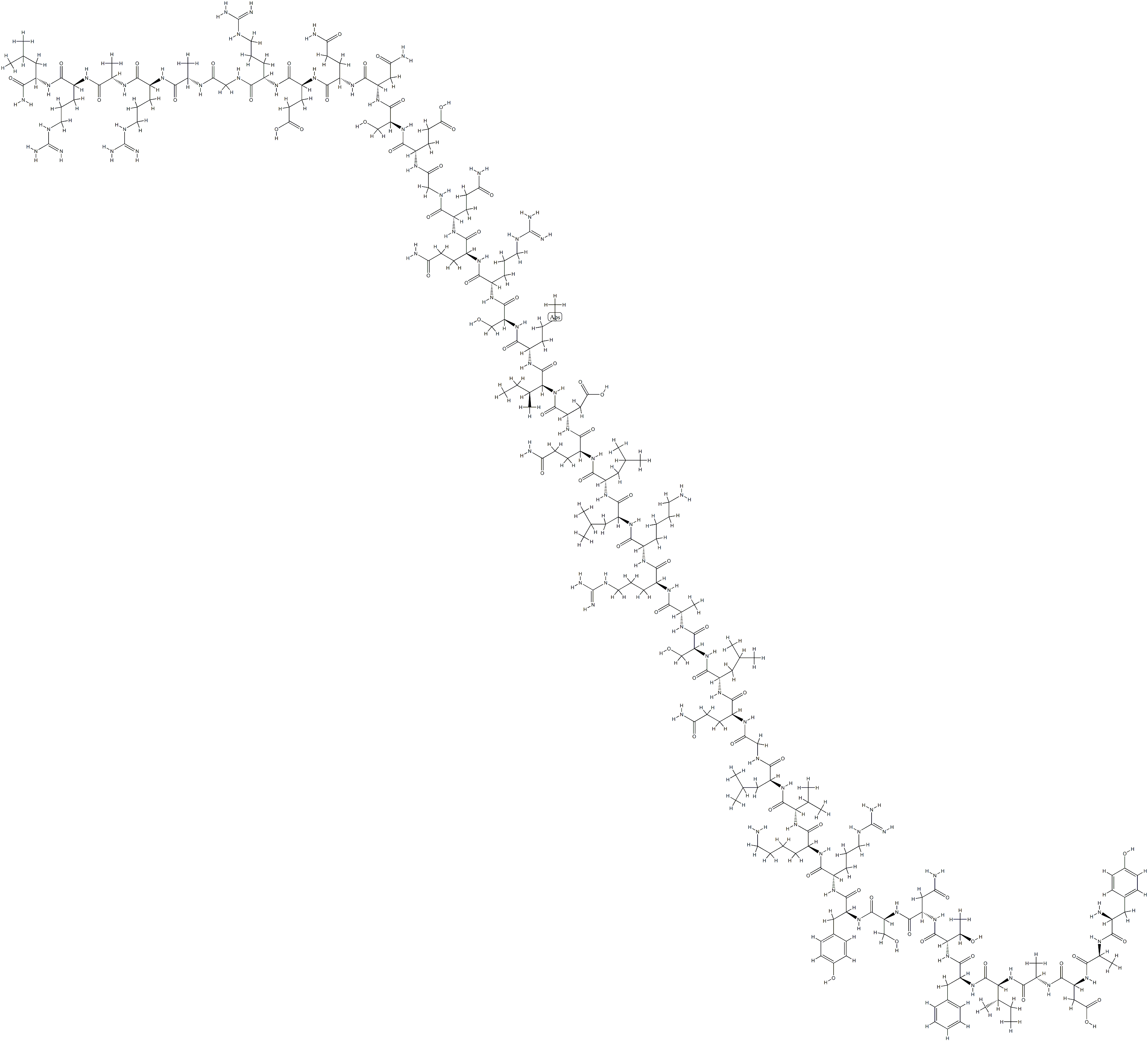SOMATOSTATIN 28, CYCLIC
- CAS NO.:73032-94-7
- Empirical Formula: C137H207N41O39S3
- Molecular Weight: 3148.56
- MDL number: MFCD01632184
- SAFETY DATA SHEET (SDS)
- Update Date: 2024-07-02 08:54:58

What is SOMATOSTATIN 28, CYCLIC?
The Uses of SOMATOSTATIN 28, CYCLIC
Somatostatin 28 has been used to study the effects of somatostatin in regulating hepatic growth hormone sensitivity. It has also been used to study its effects on insulin-like growth factor-I receptor expression in the gills of Oncorhynchus mykiss (a teleost fish).
General Description
The SST gene is mapped to human chromosome 3q27.3. Both SST-14 and SST-28 are cyclic peptide.
Hazard
A poison.
Biochem/physiol Actions
Somatostatin plays an important role in regulating the metabolism of other hormones such as growth hormone, insulin, IGF-1 (insulin-like growth factor 1), glucagon, glucagon-like peptide and gastrin. Somatostatin has both regulatory and inhibitory functions. It retards gastrointestinal motility and gallbladder contraction, suppresses gut exocrine secretion and reduces epithelial proliferation. Somatostatin is associated with intestinal nutrient absorption and blood flow regulation. This peptide hormone is believed to inhibit cell proliferation and promote apoptosis. Somatostatin acts as a neurotransmitter and neuromodulator, and is also associated in maintaining water balance.
Properties of SOMATOSTATIN 28, CYCLIC
| RTECS | WF8755700 |
| storage temp. | −20°C |
| form | Solid |
| color | White to off-white |
| CAS DataBase Reference | 73032-94-7 |
Safety information for SOMATOSTATIN 28, CYCLIC
Computed Descriptors for SOMATOSTATIN 28, CYCLIC
New Products
4-AMINO-TETRAHYDRO-PYRAN-4-CARBOXYLIC ACID HCL 4-(Dimethylamino)tetrahydro-2H-pyran-4-carbonitrile 4-Aminotetrahydropyran-4-carbonitrile Hydrochloride (R)-3-Aminobutanenitrile Hydrochloride 3-((Dimethylamino)methyl)-5-methylhexan-2-one oxalate 1,4-Dioxa-8-azaspiro[4.5]decane 5-Bromo-2-nitropyridine Nimesulide BP Aceclofenac IP/BP/EP Diclofenac Sodium IP/BP/EP/USP Mefenamic Acid IP/BP/EP/USP Ornidazole IP Diclofenac Potassium THOMAIND PAPER PH 2.0 TO 4.5 1 BOX BUFFER CAPSULE PH 9.2 - 10 CAP SODIUM CHLORIDE 0.1N CVS ALLOXAN MONOHYDRATE 98% PLATINUM 0.5% ON 3 MM ALUMINA PELLETS (TYPE 73) LITHIUM AAS SOLUTION 2-Bromo-1-(bromomethyl)-3-chloro-5-nitrobenzene 2-Bromo-3-nitroaniline N-(3-Hydroxypropyl)-N-methylacetamide 3-Bromo-6-chloropyridazine 4-ethyl-3-nitrobenzoic acidRelated products of tetrahydrofuran








You may like
-
 Somatostatin 28 CAS 73032-94-7View Details
Somatostatin 28 CAS 73032-94-7View Details
73032-94-7 -
 1-Methyl-6-oxo-1,6-dihydropyridazine-3-carbonitrile 98%View Details
1-Methyl-6-oxo-1,6-dihydropyridazine-3-carbonitrile 98%View Details
99903-60-3 -
 1823368-42-8 98%View Details
1823368-42-8 98%View Details
1823368-42-8 -
 2-(3-(tert-butyl)phenoxy)-2-methylpropanoic acid 1307449-08-6 98%View Details
2-(3-(tert-butyl)phenoxy)-2-methylpropanoic acid 1307449-08-6 98%View Details
1307449-08-6 -
 Ethyl 3-(furan-2-yl)-3-hydroxypropanoate 25408-95-1 98%View Details
Ethyl 3-(furan-2-yl)-3-hydroxypropanoate 25408-95-1 98%View Details
25408-95-1 -
 2-Chloro-5-fluoro-1-methoxy-3-methylbenzene 98%View Details
2-Chloro-5-fluoro-1-methoxy-3-methylbenzene 98%View Details
1805639-70-6 -
 1784294-80-9 98%View Details
1784294-80-9 98%View Details
1784294-80-9 -
 Lithium ClavulanateView Details
Lithium ClavulanateView Details
61177-44-4